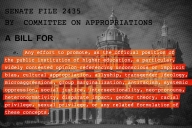You have /5 articles left.
Sign up for a free account or log in.

Photo illustration by Justin Morrison/Inside Higher Ed | Photos: iStock/Getty Images, rawpixel
Regional public institutions are at a significant “market disadvantage” when compared to other types of four-year colleges and universities, according to a new report by Art & Science Group, a higher education consulting firm.
Demographic shifts, enrollment declines and struggles to meet tuition revenue goals are challenging many higher education institutions and will be particularly challenging for regional public institutions, states the report, which was released Tuesday.
Regional public institutions educate about 3.8 million full-time students, or about 40 percent of all students earning bachelor’s degrees. These colleges also serve high numbers of first-generation, rural and low-income students.
As competition for students rises, regional institutions that historically had well-defined geographic areas from which to recruit students are increasingly subject to poaching from peer, flagship and private institutions, the report says. Higher ed experts and advocates for regional public institutions are worried that the competition for students and poor public perceptions about these colleges will further hurt them, and they are calling on both state and federal policy makers to provide greater financial support.
The report shows that, for the most part, traditional-aged students don’t perceive regional public institutions as having characteristics they value most, such as reputational stature and strength in professional fields. Regional publics lack the differentiating factors that set other colleges and universities apart in the college decision process, and this puts them at a competitive disadvantage in an increasingly competitive market.
David Strauss, principal at Art & Science Group, said it didn’t matter as much that regional public institutions lacked a competitive edge when they were the go-to choice of most students who lived within the regions where the colleges were located and the competition for students was not as intense.
“But the populations are shrinking in these areas,” he noted. “Other institutions are vying for students on the home turf of these institutions. And some of them, while they have started to try to reach beyond their catchment areas, are having limited success in doing so.
“An undifferentiated institution, one that’s not positioned to compete, is going to have a harder and harder time on its own turf and less and less success trying to reach beyond its own turf,” he said. “The route forward from here is fraught for an institution that is not offering an experience that positions it compellingly enough to cause people to choose it who wouldn’t have chosen it before.”
The survey on which the report is based explored how prospective students perceived regional colleges and universities they were considering attending relative to other types of institutions, and it analyzed the challenges regional publics may face as a result. The sample included about 1,900 high school seniors who, at the time of the survey in January and February, intended to become full-time students at four-year institutions this fall.
The report did note, however, that about half of survey respondents couldn’t correctly identify the institutional category of their first-choice college or university.
“Kids don’t think of the same categories we think of if you’re a part of the higher ed establishment,” Strauss said. Anticipating this, they had students list out the institutions in consideration and “we’ve categorized them to see whether there’s something going on that is … simply characteristic of these kinds of institutions, even if the students aren’t thinking of them in categories.”
About 35 percent of respondents said they were most likely to apply to and select a regional public institution as “a realistic first choice,” compared to 32 percent who had a preference for “flagship-like” public institutions with national reach, and 23 percent that indicated they would likely select one of three categories of private institutions.
While many prospective students considered a regional institution as their most likely choice, the report also noted that their perceptions and rankings of such institutions, when compared to national public and private institutions, implied a lack of confidence in the regional institutions.
The survey asked students to assess several colleges, each representing different institutional categories, based on 30 characteristics. The characteristics ranged from overall academic experience and student-professor interactions to stature, cost, location and the party scene.
Regional publics showed some advantage over “national publics” in student rankings of faculty-student interaction, but the regional institutions were beaten out by private institutions in this category. Regionals also performed better on strength in professional fields than private liberal arts institutions, but were not ranked higher than private research or national public institutions. Students also perceived other types of four-year institutions as having more prestige and higher academic rigor.
The only consistent advantage that students expressed about regional publics, compared to all other categories of four-year institutions, was that they tended to be cheaper.
Despite about a third of students surveyed identifying a regional public institution as their realistic first-choice college, the report projects that regional publics will still face significant challenges. Don Hossler, a provost professor emeritus in the department of educational leadership and policy at Indiana University, agreed. Hossler said the report’s findings align with what he has seen in his own research on factors that influence college enrollment, which has been the focus of his research for more than 30 years.
Hossler said the attributes that make public flagships more appealing to a broader market of students today are the same as those he observed in the 1990s, when he started his research.
“It’s the principal market disadvantages,” he said of regional institutions. “They don’t have as much visibility.” He said regional institutions are also more likely to be only considered by prospective students living within 50 to 80 miles of them.
The disadvantages predicted for many regional colleges, particularly those in the Midwest and Northeast, are already becoming evident.
The report argues that if regional institutions don’t find stronger footing, it could undermine their ability to serve students who have traditionally relied on them for access to educational opportunity and economic mobility. Low-income students were more likely to select a regional public institution as their realistic first-choice college, the report said. The average family income of respondents who indicated a preference for a regional college was $80,000, almost 25 percent lower than the average $106,000 family income of those who indicated a preference for a “flagship-like” public institution.
First-generation students were also more likely to select regional publics: about 40 percent listed a regional public as their first choice compared to about 30 percent who listed a national public institution. Other subgroups more likely to select regional publics included Black and LGBTQ+ students as well as students from rural areas.
Strauss described the regional publics as “an engine of access” that “nobody ever mentions.”
“There’s a problem here for the institutions themselves, but there’s a problem here as well for segments of our population we have real cause to be concerned about,” he said.
Kevin McClure, director of public engagement at the Alliance for Research on Regional Colleges, agreed that regional institutions face a disproportionate challenge, but he also views the report’s documentation of the demographics of students who attend regional publics as a positive result.
“It indicated that these are institutions that are serving a number of student populations that have not been well served by higher education and tend to not be well served by more exclusionary institutions,” McClure said.
The report calls for individual regional institutions to improve the student experience on their campuses in order to better position themselves to be more appealing to students, and for policy makers to pay more attention to the needs of regional colleges and provide them greater support.
“If we want a robust postsecondary education sector where there are multiple types of institutions, where it is easy for students to attend college, where they don’t have to go far away from home to do so and where they can rely on there being an option nearby that’s affordable … then we have to have a public policy commitment to that idea. And at the moment, we just don’t,” McClure said.








